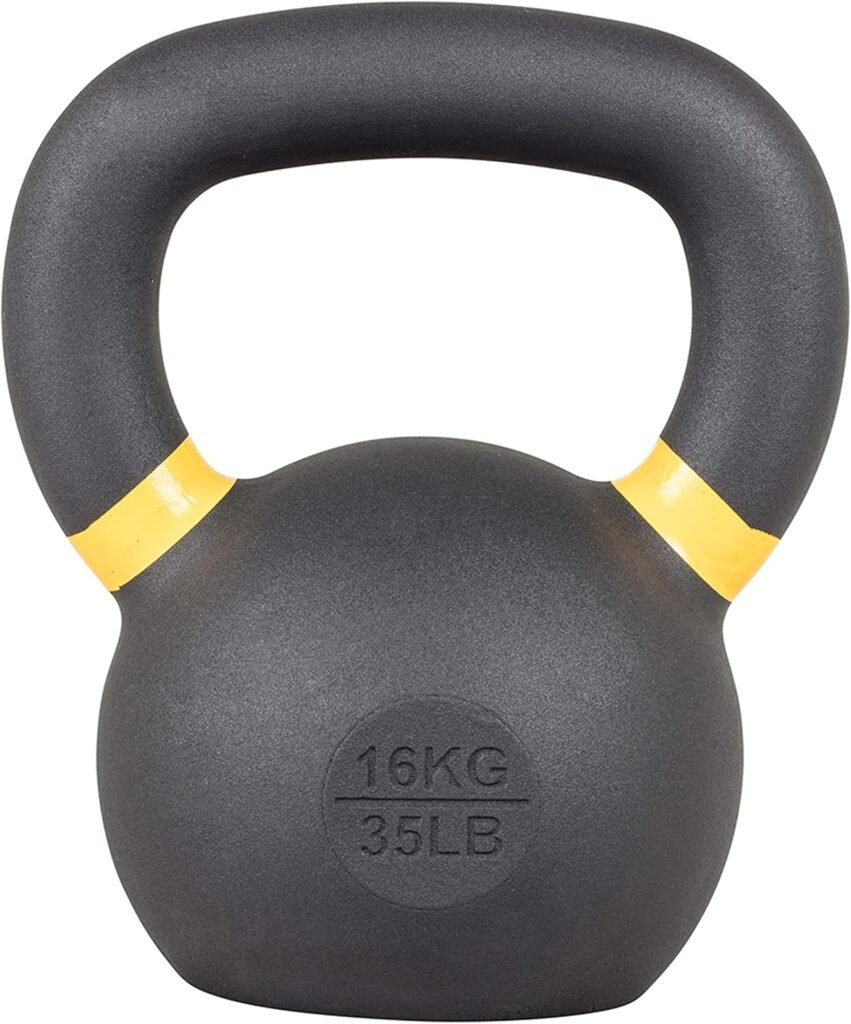Have you ever wondered how you can transform your fitness routine with just one piece of equipment? Kettlebell workouts might be the answer you’re looking for. These versatile, cannonball-shaped weights with handles pack a punch in any workout setting. Their unique shape and ability to engage multiple muscle groups make them an excellent tool for achieving both strength and conditioning goals. Let’s explore the ins and outs of working out with a kettlebell and how it can help you achieve your fitness aspirations.
You are currently viewing a placeholder content from YouTube. To access the actual content, click the button below. Please note that doing so will share data with third-party providers.
More InformationWhat is a Kettlebell?
A kettlebell is a type of weight, designed like a cast iron or steel ball with a handle attached. Originating from Russia in the 18th century, kettlebells have evolved into a popular form of workout equipment worldwide. Unlike traditional weights like dumbbells or barbells, kettlebells can be used for a variety of dynamic motion exercises. Their design requires you to stabilize your body as you work out, thereby engaging more muscle groups.
Benefits of Using a Kettlebell
Working out with kettlebells offers myriad advantages, whether your goal is to lose weight, build muscle, enhance flexibility, or increase cardiovascular endurance. Here’s why kettlebell workouts might be just what you need:
- Functional Fitness: Kettlebell exercises mimic real-life motions, helping to improve your overall functional strength.
- Core Engagement: Most kettlebell movements require a strong core, leading to a more toned and disciplined abdominal area.
- Versatility: With a single kettlebell, you can perform numerous exercises that target different muscle groups, making it a one-stop solution for your workout needs.
- Compact Size: Ideal for home workouts due to their small footprint, kettlebells don’t occupy much storage space.
- Improves Coordination and Balance: The dynamic nature of kettlebell workouts enhances your balance and coordination.
Getting Started with Kettlebell Workouts
Before diving into kettlebell exercises, it’s crucial to familiarize yourself with proper techniques. Proper form not only ensures that you maximize the benefits of your workouts but also minimizes the risk of injury.
Choosing the Right Kettlebell Weight
Selecting the correct kettlebell weight is crucial for safe and effective workouts. Here’s a general guide:
| Fitness Level | Suggested Kettlebell Weight (Men) | Suggested Kettlebell Weight (Women) |
|---|---|---|
| Beginner | 12-16 kg (26-35 lbs) | 8-12 kg (18-26 lbs) |
| Intermediate | 16-24 kg (35-53 lbs) | 12-16 kg (26-35 lbs) |
| Advanced | 24 kg (53 lbs) or more | 16 kg (35 lbs) or more |
Always remember to start with a weight that feels comfortable and manageable for you, focusing on mastering the form first.
Basic Kettlebell Techniques
When working out with kettlebells, understanding some basic techniques can pave the way for more advanced exercises. Here are a few foundational moves to get you started:
Kettlebell Swing: This iconic movement helps improve cardiovascular fitness and strengthens the posterior chain, including the glutes, hamstrings, and lower back.
Goblet Squat: Holding a kettlebell at chest height, you perform a squat, which enhances thigh, glute, and core strength.
Kettlebell Deadlift: This exercise targets the lower body and back, emphasizing proper lifting techniques.
Turkish Get-Up: A full-body exercise that requires you to move from a lying position to standing while holding a kettlebell overhead. This move builds overall strength and coordination.
Mastering these basic exercises will build a strong foundation, allowing you to progress to more complex movements as you become more comfortable.

Structuring Your Kettlebell Workout
Creating an effective kettlebell workout plan involves not only knowing the exercises but also structuring them in a way that aligns with your fitness goals. Here’s how you can go about it:
Designing Your Workout Routine
A proper kettlebell workout plan seamlessly integrates different exercises that collectively target various muscle groups. Here’s a simple template to help you tailor a routine:
Warm-Up (5-10 Minutes): Start with dynamic stretches and light cardio to get your blood flowing and muscles ready.
Strength Training (20-30 Minutes): Choose compound movements such as kettlebell swings, squats, and deadlifts. Perform 3-4 sets of each exercise with 8-12 reps per set. Rest for 30-60 seconds between sets.
Conditioning/Cardio (10-15 Minutes): Incorporate high-intensity moves like kettlebell snatches or swings at intervals to elevate your heart rate.
Cool Down (5-10 Minutes): End your session with static stretches focusing on the muscles you’ve worked to promote recovery and flexibility.
Sample Kettlebell Workout
Feeling inspired to try a workout? Here’s a sample routine that covers both strength and cardio elements:
Warm-Up:
- Jumping Jacks: 1 minute
- Arm Circles: 1 minute
- Leg Swings: 1 minute
Main Workout:
| Exercise | Reps | Sets |
|---|---|---|
| Kettlebell Swing | 15 | 3 |
| Goblet Squat | 12 | 3 |
| Kettlebell Deadlift | 10 | 3 |
| Turkish Get-Up | 5 | 3 (each side) |
| Kettlebell Snatch | 8 | 3 (each side) |
Cool Down:
- Hamstring Stretch: 30 seconds per leg
- Quadriceps Stretch: 30 seconds per leg
- Shoulder Stretch: 30 seconds each arm
Modify this routine to suit your level of fitness and specific goals. Consistency is key, and over time you can increase weights and reps for progressive overload.
Safety Tips and Common Mistakes
Safety is paramount in any fitness regimen, and kettlebell workouts are no exception. Proper form and technique can prevent injuries and ensure you get the most out of your exercises.
Avoiding Injury While Using Kettlebells
Here are some tips to keep in mind:
Maintain Proper Form: Ensure your back is straight and core engaged throughout movements. Avoid rounded shoulders or slouched posture, especially during swings or squats.
Warm-Up Thoroughly: Always prepare your body with a good warm-up to activate muscles and prevent strains.
Start Light: Begin with lighter weights to get acquainted with the moves and gradually increase the load as your confidence and strength grow.
Listen to Your Body: If you feel any sharp pain or discomfort during an exercise, stop immediately. It’s crucial to differentiate between the good ‘burn’ of a workout and pain that might signal an injury.
Common Kettlebell Workout Mistakes
Being aware of common mistakes can help refine your technique:
Using the Arms Instead of Hips: In motions like the kettlebell swing, power should come from the hips, not the arms. Focus on generating force from your lower body.
Incorrect Gripping: Avoid a death grip. Instead of tightly holding the handle, aim for a relaxed and secure hold.
Neglecting Breathing Techniques: Proper breathing enhances performance and reduces fatigue. For instance, exhale during exertion and inhale during relaxation phases.
Rushing Through Movements: Prioritize form over speed. Performing exercises too quickly can lead to loss of technique and increase the chance of injury.
Progressing Your Kettlebell Workouts
Once you’ve mastered the basics and feel comfortable with your current routine, it’s time to level up. Progression is essential for continual improvement and avoiding plateaus.
Increasing Intensity and Complexity
Try these strategies for progressing your kettlebell workouts:
Add Load: Gradually increase the weight of your kettlebell as you build strength.
Incorporate Complex Movements: Introduce exercises like the kettlebell clean and press or windmills that challenge multiple muscle groups and require a higher level of coordination.
Increase Reps and Sets: As your endurance improves, increase the number of sets or repetitions of your exercises.
Reduce Rest Times: For enhanced cardiovascular benefit, reduce rest intervals between sets.
Advanced Kettlebell Exercises
Here are some exercises to explore as you advance:
Kettlebell Clean and Press: This full-body move enhances strength and power by combining a clean movement with an overhead press.
Kettlebell Windmill: Targeting the obliques and shoulder stability, this exercise helps in building functional strength.
Kettlebell Snatch: An advanced explosive lift that builds endurance and agility.
Fusing these into your routine will add variety and challenge, keeping workouts engaging and productive.
Integrating Kettlebells with Other Workouts
Kettlebells can complement other forms of fitness, providing a well-rounded exercise regimen.
Combining Kettlebells with Traditional Weightlifting
Adding kettlebells to your weightlifting routine can introduce elements of cardiovascular training while maintaining strength-building objectives. Use kettlebells on your high-rep or conditioning days to keep muscles challenged.
Kettlebells in Functional Training
Functional training focuses on movements that simulate daily activities. Kettlebells are a great fit for functional workouts due to their promotion of stability and multi-directional strength.
Example Exercise Combination:
- A circuit of kettlebell swings, lunges, and jump squats can enhance both functional mobility and conditioning.
Tracking Your Progress and Setting Goals
Tracking progress is pivotal to assess improvements and stay motivated. Set SMART (Specific, Measurable, Achievable, Relevant, Time-bound) goals to keep your workouts focused.
How to Track Your Kettlebell Achievements
Here are a few metrics you can monitor:
Reps and Sets: Keep a record of how many reps and sets you’re completing for each exercise.
Weights Used: Chart the weight of kettlebells you’re working with over time.
Progress Photos: Document changes with regular photos to visually gauge transformations.
Performance Improvements: Track reductions in rest time or improvements in recovery and endurance.
This thoughtful tracking enables you to make informed decisions about when and how to intensify your workouts.
Conclusion
Kettlebell workouts stand out for their capacity to develop strength, endurance, and agility, all with a single piece of equipment. Embrace the versatility and simplicity of kettlebells to invigorate your fitness routine. Begin with the basics, maintain proper form, and progressively step up your workouts for optimal results. As you journey with kettlebells, you’ll uncover their unique potential to transform your fitness experience, delivering results that align with your personal health goals. Always remember to enjoy the process and listen to your body as you build a committed and rewarding kettlebell practice.






